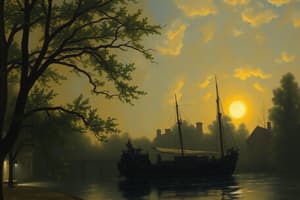Podcast
Questions and Answers
Which of the following best describes folk culture?
Which of the following best describes folk culture?
- Homogeneous populations (correct)
- Changes rapidly
- Not commodified (correct)
- Practiced by a large, urban population
Which of the following best describes popular culture?
Which of the following best describes popular culture?
- Commodified on a global scale (correct)
- Found in isolated rural areas
- Traditional practices of small communities
- Changes slowly
What are the hearths of folk culture?
What are the hearths of folk culture?
Folk customs are deeply embedded in local culture with unknown innovator, arising from everyday activities of rural life.
What are the hearths of popular culture?
What are the hearths of popular culture?
What are the typical patterns of diffusion for folk culture?
What are the typical patterns of diffusion for folk culture?
What are the typical patterns of diffusion for popular culture?
What are the typical patterns of diffusion for popular culture?
What is the current distribution of folk culture?
What is the current distribution of folk culture?
What is the current distribution of popular culture?
What is the current distribution of popular culture?
What is the typical cultural landscape for folk culture?
What is the typical cultural landscape for folk culture?
What is the typical cultural landscape for popular culture?
What is the typical cultural landscape for popular culture?
Provide an example of how agriculture affects the cultural landscape in folk cultures.
Provide an example of how agriculture affects the cultural landscape in folk cultures.
Provide an example of how clothing affects the cultural landscape in folk cultures.
Provide an example of how clothing affects the cultural landscape in folk cultures.
Study Notes
Folk Culture
- Characterized by traditions of small, rural, homogeneous populations.
- Develops slowly and varies significantly across regions.
- Not commodified, maintaining local authenticity.
Popular Culture
- Found in large, urban, heterogeneous populations with shared cultural traits.
- Changes rapidly and shows little variation between locations.
- Commodified at a global scale, influencing mainstream trends.
Hearths of Folk Culture
- Origins are generally unknown; derived from local customs and daily rural life activities.
- Deeply embedded in the culture, making specific innovators difficult to identify.
Hearths of Popular Culture
- Innovations are identifiable with specific times, places, and innovators, typically in major cities of North America, Europe, and Japan.
- Emerges from industrial advancements and increased leisure time.
Diffusion of Folk Culture
- Spreads through relocation diffusion, often accompanying migrating populations.
- Transmitted slowly on a smaller scale compared to popular culture.
Diffusion of Popular Culture
- Follows hierarchical diffusion from innovation nodes, spreading rapidly and broadly.
- Utilizes modern communication and transportation for extensive distribution.
Current Distribution of Folk Culture
- Predominantly found in isolated areas of Less Developed Countries (LDCs) and some rural regions of More Developed Countries (MDCs).
- Also present in ethnic enclaves within urban settings, where cultural isolation is maintained.
Current Distribution of Popular Culture
- Widespread and globally distributed, with prevalence in urban centers.
- Represents a dominant influence over local cultures.
Cultural Landscape of Folk Culture
- Reflects local environments, utilizing local materials for food, clothing, and built structures.
- Less likely to harm the natural environment due to small-scale practices and limited technology.
Cultural Landscape of Popular Culture
- Often modifies or damages local environments due to mass production and imports.
- Creates uniform landscapes, leading to "placelessness" where local diversity in food, clothing, and architecture diminishes.
Examples of Agriculture/Food in Folk Cultures
- Differences in cooking methods (e.g., quick-frying in Italy vs. slow stewing in northern Europe) influenced by local resources.
- Crop cultivation based on climate: rice in mild climates, wheat in colder ones.
- Regional specialties, like locally produced wine reflecting local soil characteristics.
- Cultural prohibitions, such as the Middle Eastern avoidance of pork, preserving resources like water and grain.
- Hindu practices protecting cattle for agricultural purposes, avoiding beef consumption.
Examples of Clothing in Folk Cultures
- Climate influences footwear needs: fur-lined boots for arctic conditions versus minimal footwear in humid climates.
- Dutch wooden shoes designed for wet climates.
- Traditional clothing made from local materials, exemplified by Amish, Inuit, and African cultures.
Built Environment in Folk Cultures
- Local construction practices reflect environmental resources and cultural customs, shaping distinct architectural styles.
Studying That Suits You
Use AI to generate personalized quizzes and flashcards to suit your learning preferences.
Description
Explore the fundamental characteristics of pop and folk culture through this study guide quiz. Learn about the defining features of these cultures and how they differ from one another. Perfect for students looking to enhance their understanding of cultural studies.




